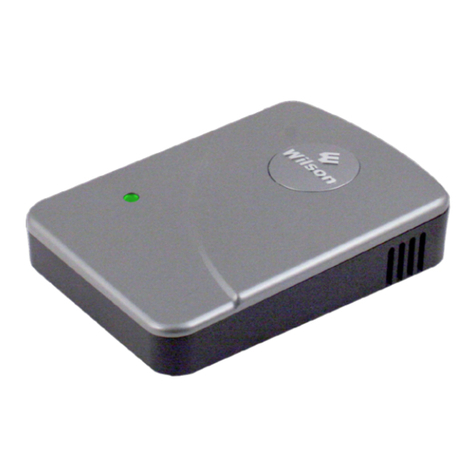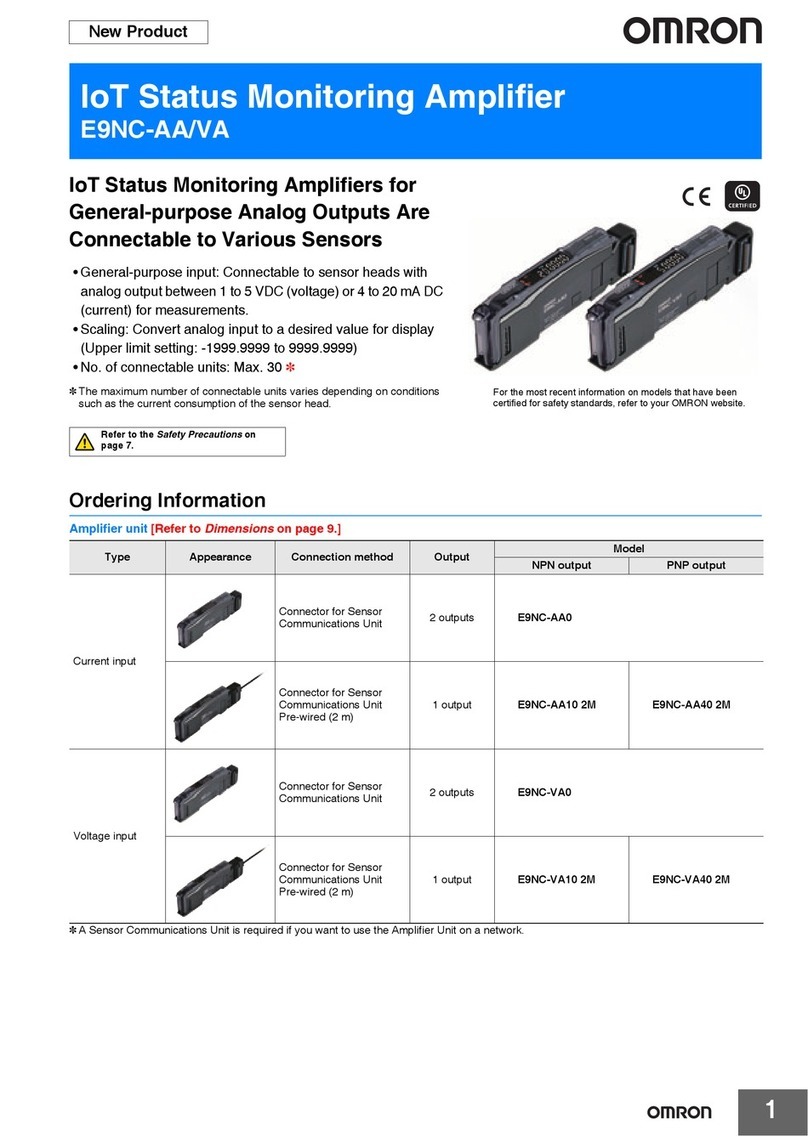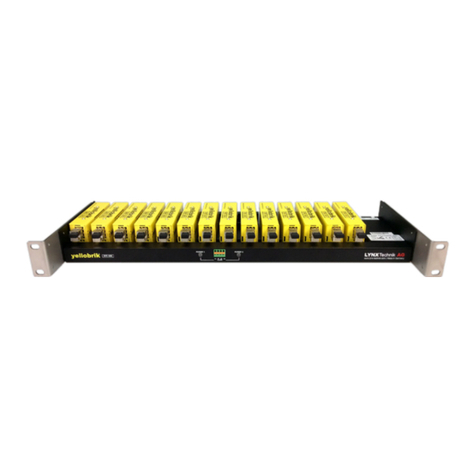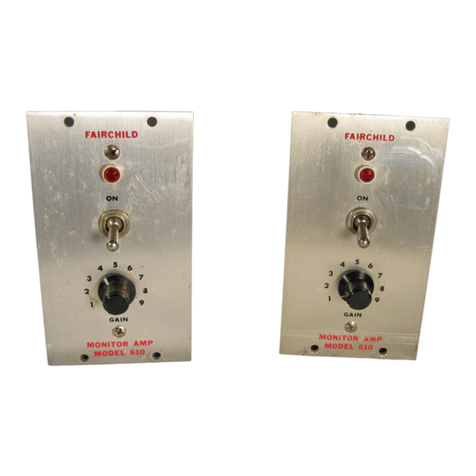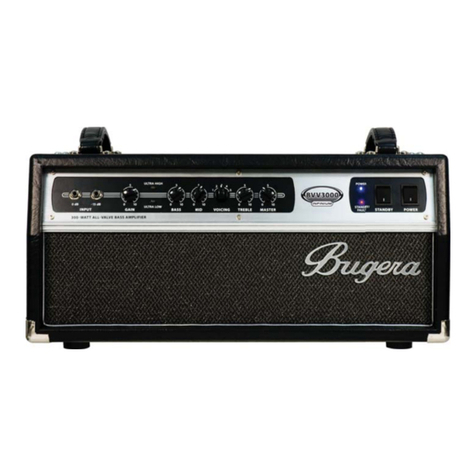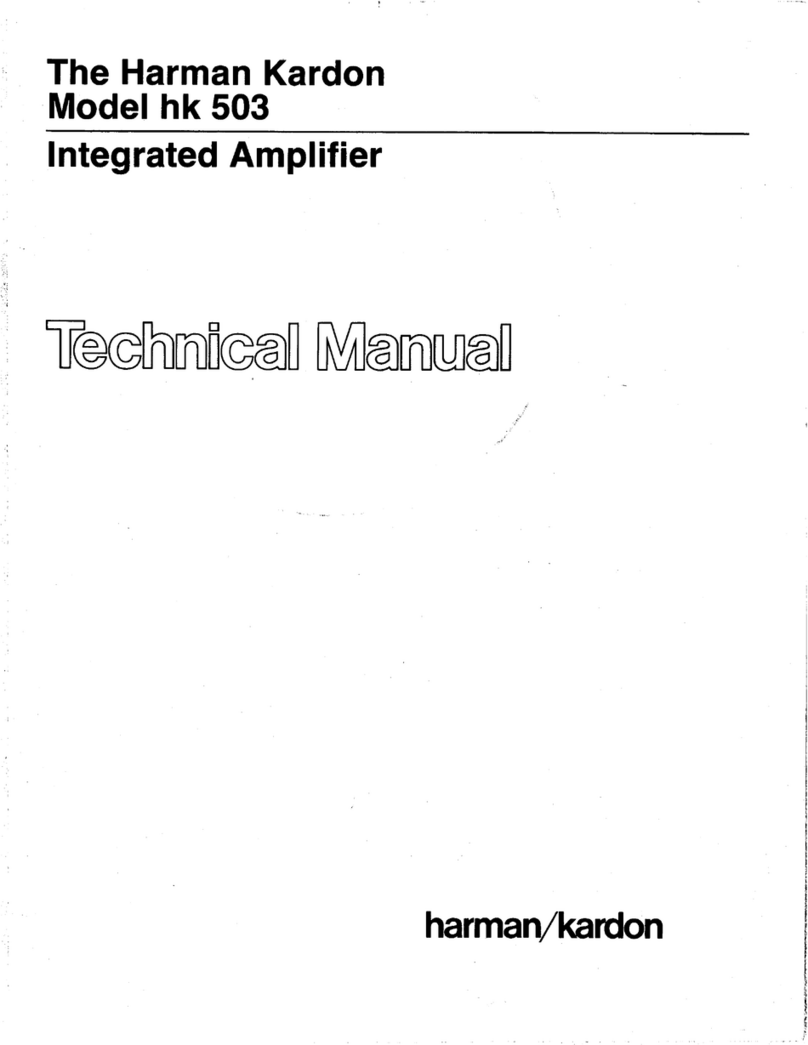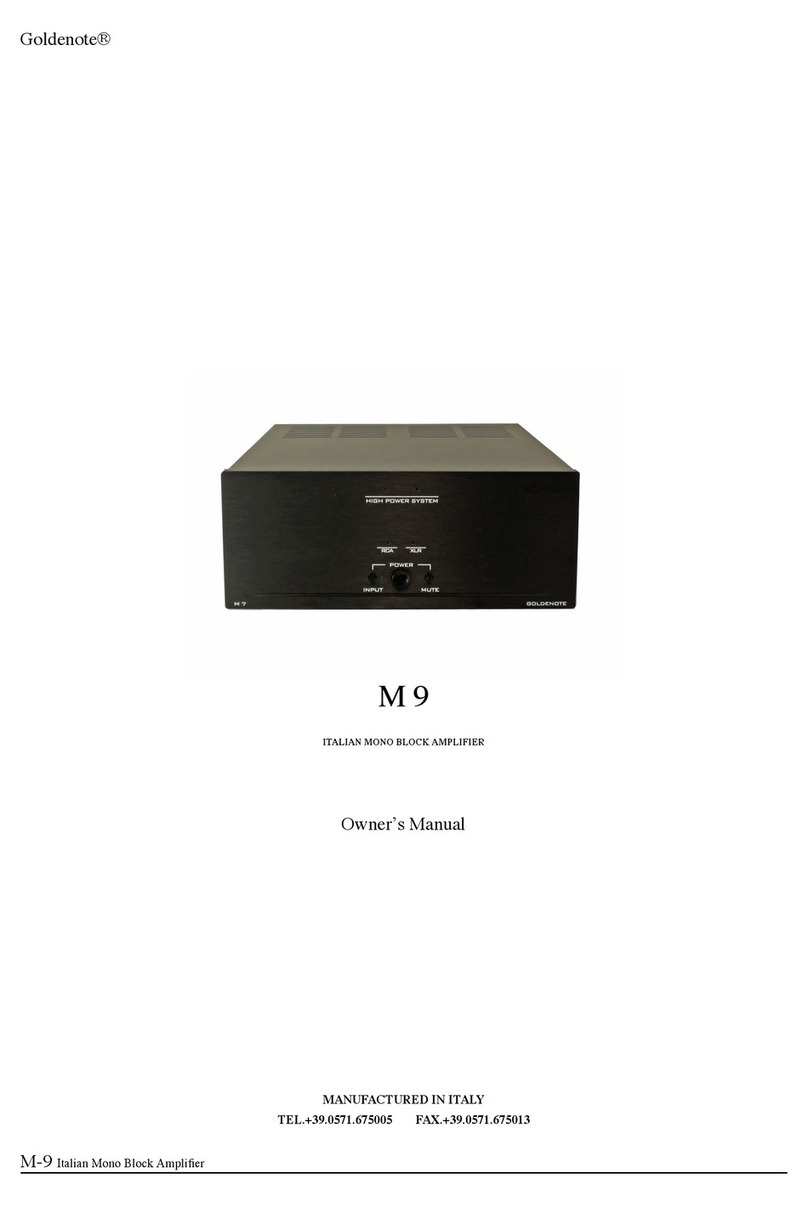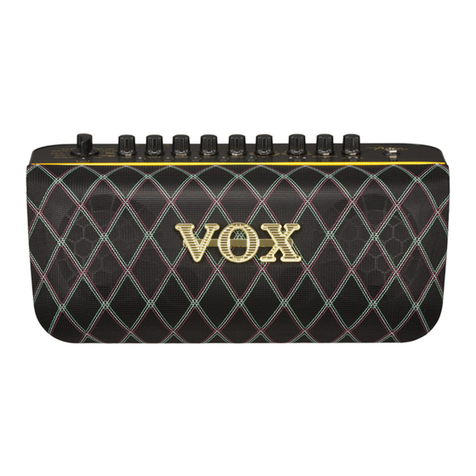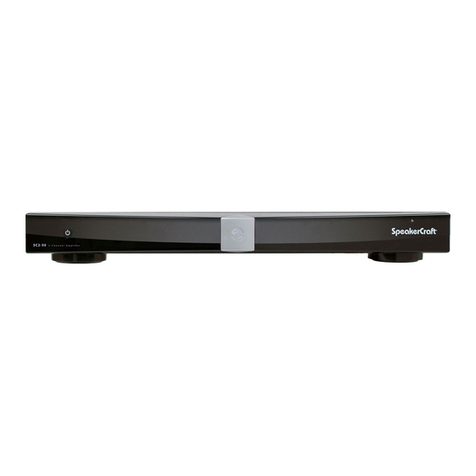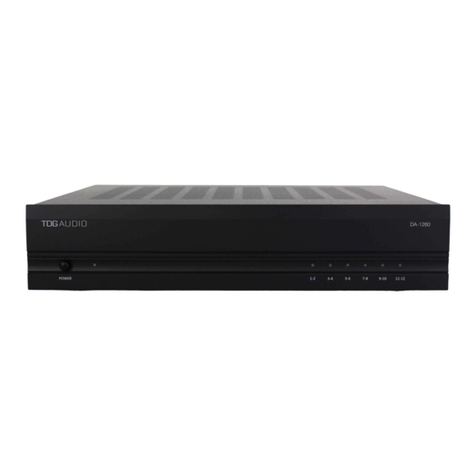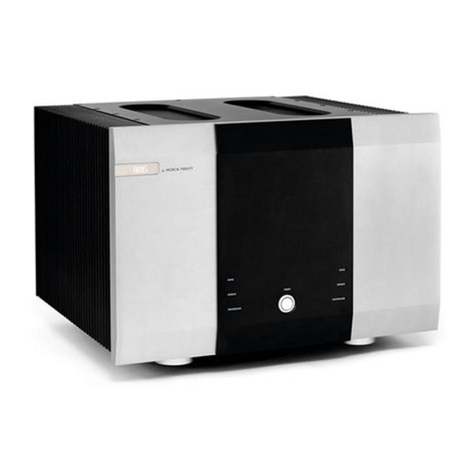Trinity Amps OSD User manual

Trinity Amps OSD Builders Guide Ver. 1.25.docx
- 1 -
OSD
Overdrive Special Design
Builders Guide
For the sole personal use of Trinity Amps Customers.
February 2019, Version 1.25
Parts © Trinity Amps 2005 - 2020
www.trinityamps.com

Trinity Amps OSD Builders Guide Ver. 1.25.docx
- 2 -

Trinity Amps OSD Builders Guide Ver. 1.25.docx
- 3 -
Thank You
Thank you for purchasing your OSD kit from Trinity Amps. We truly hope that you enjoy building
it and that it will be enjoyed for many years. If you have any questions please do not hesitate to
contact us and. Please be sure to check the package contents in case there are any missing items.
We are always looking for feedback form our Customers on our products. We have checked the
build instructions over thoroughly and are confident in our product. However, mistakes do
happen so our advice is that as you connect each wire and part according to the layout, cross-check
against the schematic. If you find any inconsistencies, or have any concerns, please let us know.
Do not hesitate to contact us! We want this build to be successful for you and for Trinity Amps!
We’re confident that you will like our product and our support and when you’re completed, we’d
appreciate your comments posted on any of the internet forums such as thegearpage.net,
18watt.com, AX84.com or trinityamps.com. You will find some extra business cards in the
package. Please keep one and pass the rest around.
We know you have a choice in suppliers and do appreciate your business. If there is any other
product we can provide to you or your associates, please get in touch and we will be happy to
discuss requirements.
Sincerely,
Stephen Cohrs,
Trinity Amps
Web site: www.trinityamps.com
email: stephen@trinityamps.com

Trinity Amps OSD Builders Guide Ver. 1.25.docx
- 4 -

Trinity Amps OSD Builders Guide Ver. 1.25.docx
- 5 -
Table of Contents
Table of Contents..................................................................................................................................................................................... 3
Introduction .............................................................................................................................................................................................. 7
Acknowledgements.................................................................................................................................................................................. 7
WARNING............................................................................................................................................................................................... 8
Please Read this Information Carefully..................................................................................................................................... 8
Version Control ........................................................................................................................................................................................ 9
About the OSD ...................................................................................................................................................................................... 11
Guitar Amplifier Basics......................................................................................................................................................................... 12
Dumble Tone Stack –from Merlin............................................................................................................................................... 15
General Amplifier Operation............................................................................................................................................................... 17
Some DO NOTS......................................................................................................................................................................... 17
Some DOs.......................................................................................................................................................................................... 17
Introduction to Vacuum Tubes and Common Terms .................................................................................................................... 18
Building an Amp..................................................................................................................................................................................... 21
Introduction....................................................................................................................................................................................... 21
Switches and wire.............................................................................................................................................................................. 21
Physical layout ................................................................................................................................................................................... 21
Grounding.......................................................................................................................................................................................... 21
Insulated jacks ................................................................................................................................................................................... 22
Minimizing transformer interference ............................................................................................................................................ 22
Wiring ................................................................................................................................................................................................. 22
Assembling the amp .............................................................................................................................................................................. 23
Before You Begin ............................................................................................................................................................................. 23
Tools ................................................................................................................................................................................................... 23
Soldering............................................................................................................................................................................................. 23
Tube Pin Numbering ....................................................................................................................................................................... 24
Check Your Kit....................................................................................................................................................................................... 25
OSD Build Steps Summary .................................................................................................................................................................. 25
1. Install all the Hardware ..................................................................................................................................................................... 26
2. Install Terminal Strips ....................................................................................................................................................................... 30
3. Install Terminal Strip Components ................................................................................................................................................ 35
4 Install Components on the Send Return Jacks and Bias Points ................................................................................................. 38
5 Install the ground bus ........................................................................................................................................................................ 39
6 Connect Components to the ground bus ....................................................................................................................................... 40
7 Build the RELAY board .................................................................................................................................................................... 44
8 Install the Power Transformer and Output Transformer ........................................................................................................... 47
Wire the Output Transformer .................................................................................................................................................. 47
Wire the Impedance Selector and Output Jacks.................................................................................................................... 49
9 Wiring the Power Transformer Primary Leads ............................................................................................................................. 50
120V Mains........................................................................................................................................................................................ 50
240V Mains........................................................................................................................................................................................ 51
Test the Power Transformer..................................................................................................................................................... 52
Test the Overdrive RELAY Board .......................................................................................................................................... 54
10 Build the Eyelet Board. Install it in the Chassis ......................................................................................................................... 55
Eyelet Board General Assembly Notes ........................................................................................................................................ 57
Eyelet Board Assembly .............................................................................................................................................................. 59
11 Connect Eyelet Board Ground Points.......................................................................................................................................... 66
12 Connecting the Eyelet Board to Tube Sockets ........................................................................................................................... 67
13 Connecting the Eyelet Board to the Controls ............................................................................................................................. 72
Shielded Cable.............................................................................................................................................................................. 72

Trinity Amps OSD Builders Guide Ver. 1.25.docx
- 6 -
14 Wire the RELAY Board to the Foot Switch Chassis Socket. ................................................................................................... 80
15 Complete the Power Transformer Secondary Wiring................................................................................................................ 82
16 Complete Output Transformer Wiring......................................................................................................................................... 85
17 Wire the Heaters ............................................................................................................................................................................... 87
18 Double Check.................................................................................................................................................................................... 89
19 Build the Footswitch Box, Cable and DIN connector. ............................................................................................................. 90
20 Start-Up Procedure........................................................................................................................................................................... 91
Making a Voltage Measurement..................................................................................................................................................... 91
Discharging the Power Supply ....................................................................................................................................................... 91
Quick OSD Setup .................................................................................................................................................................................. 94
Using the OSD Controls....................................................................................................................................................................... 95
Trinity Amps OSD OSD 6V6 Voltage Chart ................................................................................................................................... 96
Trinity Amps OSD 6L6 Voltage Chart .............................................................................................................................................. 97
WARNING............................................................................................................................................................................................. 98
Read This Information Carefully.............................................................................................................................................. 98
Troubleshooting ..................................................................................................................................................................................... 99
Hum .................................................................................................................................................................................................... 99
Volume Test ...................................................................................................................................................................................... 99
Faulty tube ....................................................................................................................................................................................... 100
Severely unmatched output tubes in a push pull amplifier .....................................................................................................100
Faulty power supply filter caps..................................................................................................................................................... 100
Faulty bias supply in fixed bias amplifiers ..................................................................................................................................101
Unbalanced or not-ground-referenced filament winding........................................................................................................101
Defective input jack........................................................................................................................................................................101
Poor AC grounding........................................................................................................................................................................101
Induced hum.................................................................................................................................................................................... 101
Poor internal wire routing .............................................................................................................................................................102
Poor AC Chassis Ground at Power Transformer ....................................................................................................................102
Defective internal grounding ........................................................................................................................................................102
Hiss.................................................................................................................................................................................................... 102
Metal Film Resistor Substitutions................................................................................................................................................ 102
Squealing/Feedback ....................................................................................................................................................................... 103
Radio Interference .......................................................................................................................................................................... 103
Scratchy Sounds on Potentiometer(s).........................................................................................................................................103
Amp Buzz or Rattle When Installed in Cabinet........................................................................................................................103
Tone Tweaking .....................................................................................................................................................................................106
General Tips for fine tuning your amp.......................................................................................................................................106
Appendix 1 - Running 6L6 Tubes in the OSD...............................................................................................................................108
Calculating Power Tube Bias ........................................................................................................................................................ 108
Appendix 2 - Installing the Buffered Effects Loop ....................................................................................................................... 109
Appendix 3 - How to read Resistor Color Codes .......................................................................................................................... 112
First the code .............................................................................................................................................................................112
How to read the Color Code .................................................................................................................................................. 112
Appendix 4 - How to read Capacitor Codes ...................................................................................................................................113
Appendix 5 - FAQ ...............................................................................................................................................................................115
Appendix 6 - Cliff Jacks Explained...................................................................................................................................................117
Appendix 7 –Additional Mains Wiring Schematics ...................................................................................................................... 118
Appendix 8- OSD Bill of Materials................................................................................................................................................... 120
ADDENDUM –FOOTSWITCH - RELAY BOARD CONNECTION...............................................................................124
Trinity Amps Schematics and Layouts .............................................................................................................................................126

Trinity Amps OSD Builders Guide Ver. 1.25.docx
- 7 -
Introduction
This guide has been prepared for builders of Trinity Amps Kits. It is always being improved
and we would appreciate your feedback and comments to: stephen@trinityamps.com
Accordingly, content and specifications are subject to change without notice.
We do try to make it as accurate as possible, but it is sometimes hard to keep up with the
changes. Therefore, if you do find an error, please let us know about it and we will correct it.
Suggestions are welcome so if you have one, please get in touch with us.
Sources of help.
Forums: Please use the various forums to get help. They are an excellent resource and can
be found at trinityamps.com, AX84.com, the Gear Page etc..
Color assembly pictures and the latest drawings, tips, techniques are all in the Trinity Amps
Forum, in the Resources Forum. To view the Resources, you need to sign up so go to
www.trinityamps.com and click on the Forum button.
Email: We can’t help with every problem but if you can not get your problem resolved, email
us and we’ll do our best to help.
Phone Call: If your problem can’t be solved, email for a phone appointment.
Acknowledgements
Much of the content in this document is original. Rather than reinvent content, some parts
are based on content from other excellent sources and are hereby acknowledged.
R.G. Keen’s site www.geofex.com - Tube Amp FAQ, Tube Amp Debugging
AX84.com site www.AX84.com - Gary Anwyl's P1 construction guide version 1.0
www.18watt.com - website for various content and diagrams –Richie TMB
Aron from www.diystompboxes.com
Parts © Trinity Amps 2005. No part of this document may be copied or reprinted without
written permission of Trinity Amps or contributing authors listed above.

Trinity Amps OSD Builders Guide Ver. 1.25.docx
- 8 -
WARNING
Please Read this Information Carefully
The projects described in these pages utilize POTENTIALLY FATAL HIGH
VOLTAGES. If you are in any way unfamiliar with high voltage circuits or are
uncomfortable working around high voltages, PLEASE DO NOT RISK YOUR LIFE
BY BUILDING THEM.Seek help from a competent technician before building any
unfamiliar electronics circuit. While efforts are made to ensure accuracy of these circuits, no
guarantee is provided, of any kind!
USE AT YOUR OWN RISK:
TRINITY AMPS EXPRESSLY DISCLAIM ALL
LIABILITY FOR INJURY OR PROPERTY DAMAGE RESULTING FROM THIS
INFORMATION! ALL INFORMATION IS PROVIDED 'AS-IS' AND WITHOUT
WARRANTY OF ANY KIND.
REMEMBER: NEVER OPERATE YOUR AMP WITHOUT A LOAD. YOU WILL
RUIN YOUR OUTPUT TRANSFORMER!

Trinity Amps OSD Builders Guide Ver. 1.25.docx
- 9 -
Version Control
Version
Date
Change
1.0
14Dec17
FIRST RELEASE
1.01
26Dec17
Note added to modify terminal strips and mounting ground lugs
1.02
27Dec17
Added description of Power/Stand-by switch installation with washer; Tone
Tweaking note enhanced.
1.03
29Dec17
Mod instructions around installing 5K Trim Pot and PI components section (A.
McKay) Added addendum for insulating the mounting screw in PI section close to
Trim Pot.
1.04
31Dec17
Added note on tying off 100V Black/White and White / Black when not use in 120
or 240V implementations
1.05
29Jan18
Updated Relay testing procedure (J. Ianieri)
1.06
30Jan18
Corrected SEND JACK connection to Master Volume (not eyelet board) (C. Gwyn)
1.07
5Feb18
Updated orientation of Relays on board. (K. Matsumoto)
1.08
12Feb
Removed jumper on mid control pins 2-3 . (C. Gwyn)
1.09
9Mar
Corrected parts list for Preamp Components (2) section to 2- 10uF bypass caps and 1
–150K 1% resistor. (B.Manker)
1.10
14Mar
Corrected Rock/Jazz switch terminal numbers to “Solder a jumper between pins 1
and 4 on the DPDT switch”. Corrected description and quantity of DPDT Mini
Toggle Switch to ‘3’ in BOM (M. Johnson)
1.11
19Mar18
Updated jumper wires p.54 (M. Johnson)
1.12
22Mar18
Changed procedure to connect lead from DPDT JAZZ/ROCK switch terminal 2
(was 3) to PAB RELAY 2, NC terminal (B. Manker). Corrected 240V hook-up and
PT schematics. Appendix with all mains voltages supported (N. Kehlet)
1.13-1.14
7Aug18
Updated BOM per feedback from R. Vaivads
1.15
9Aug18
Corrected TRIM Control pot wiring and FX board installation
1.17
22Oct18
Updated BOM
1.18
4Dec18
Updated per feedback from R. Vaivads: .clarified bias pot install; updated drawings
for 600V OD caps; updated BOM
1.19
22Dec18
Updated for new (black) relay board installation and testing.
1.20
10Jan19
Updated OD RELAY connections to eyelet board (R. Vaivads)
1.21
15Feb19
Updated all relay drawings in manual
1.22
19Feb19
Updated OSD COM Relay connections thru manual
1.23
10Mar
Update 240V connection text. Corrected PI Components text; added 1 stand-off to
BOM (V. Sundberg)
1.24
6Apr19
Note added about FX return connection location option and PI balancing with
matched triode tube.
1.25
14Feb20
Updated BOM

Trinity Amps OSD Builders Guide Ver. 1.25.docx
- 10 -

Trinity Amps OSD Builders Guide Ver. 1.25.docx
- 11 -
About the OSD
Dumble amplifiers are synonymous with the rarest finest boutique amplifiers. Alexander
“Howard” Dumble started building the legendary amplifiers in the 60’s in southern
California. Over time he designed and hand-built and tweaked many amps that were used by
Stevie Ray Vaughn, Eric Johnson, Carlos Santana, John Mayer, Robben Ford, Larry Carlton
etc..
The Overdrive Special (ODS) is by far Dumble’s most well-known and popular amp. As a
result they are Dumble’s most produced amp with approximately 250 built. With previously
owned ODS’ easily selling for over $100,000 USD these days online they are not your
average basement rockers amp.
The Trinity Amps OSD is modelled after the 100W Dumble ODS #124 with just a few less
frills. It boasts a nominal 24W output in a compact format of only 15-1/2 in W X 7-1/2”
in H X 9-1/2 in D and 25 lbs., two channels - Clean and Overdrive. The amp uses using
6V6 output tubes in fixed bias mode. Since most on-stage set-ups are miked, 100 watts
power is almost never required and 24 watts is both sufficient and surprisingly loud even for
medium gigs, especially in this design. This lower wattage helps keep volume levels
manageable and makes it very useful in a studio. There is also an option to run 6L^ for
slightly higher (33 watts)power.
The preamp has three 12AX7 tubes which are used for the Clean channel, Overdrive
channel and the Phase Inverter. On the back of the amp there is a control to configure
Overdrive channel Trim. The Overdrive channel and Pre-Amp Boost (PAB) are activated
with a footswitch connected to the back of the amp. There is also a passive effects loop, like
in the originals. This is very effective if, for example, you want to inject some reverb. We
have used a Holy Grail Reverb pedal here and it works very well.
The “spanky” clean preamp has a percussive nature is extremely inspirational. This preamp
stays nice and clean and allows you to crank the power amp to achieve a highly percussive
tone that taps into the compression and sustain of the power amp tubes.
The magic of the OSD comes from the Overdrive channel sound. The Overdrive channel
provides a very smooth, sweet sustaining distorted tone. Activating the Overdrive circuit
adds two additional gain stages and the result is an Overdrive that ranges from clean and
harmonically rich to smooth and thick with ample saturation.

Trinity Amps OSD Builders Guide Ver. 1.25.docx
- 12 -
Guitar Amplifier Basics
Electric guitarists can be fairly criticized for their reluctance to change to new ideas
and technologies; however, there is no doubt that a classic 1950’s guitar and tube
amplifier in good condition still sounds great in modern recordings. This is a
testament to good design from the start. What has improved today is consistency,
and the cost benefits of production line manufacturing. This is offset by the rarity of
good guitar wood (it makes a huge difference, even on an electric guitar), increased
labour costs for both guitars and amplification equipment, and the availability of good
and consistent quality tubes.
There is also an element of nostalgia, with memories of many of the great players of
years gone by, and the desire to use the same types of instruments and equipment to
recapture the magic. Vintage instruments and equipment have also become valuable
collectors items (some with very inflated prices) which adds further to the desirability
of older tools of the trade. There has been a recent trend by many companies to re-
market their original instruments and equipment; new guitars can even be bought now
‘pre-aged’!
This desire for vintage equipment is also related to guitarists’ reluctance to part with
tube amplification, and there are many reasons why tube and solid state amplifiers
behave differently. Quite simply, if players prefer the sound of tubes, they will
continue to buy and use them. Below are some fundamentals.

Trinity Amps OSD Builders Guide Ver. 1.25.docx
- 13 -
Input Impedance
Typically 1M, 500K minimum (humbucking pickup guitars have
volume pots up to 500K, single coil pickup guitars typically of 250K) .
Tone Controls
Magnetic guitar pickups are inductive, and require compensation,
although this opportunity is also used for tone enhancement, not just correction. Without
compensation, they have a strong low middle emphasis and little high frequency response -
overall a very muddy and muffled sound. This is why typical hi-fi Baxandall treble & bass
controls are unsuitable.
To hear the natural sound of a pickup, use a typical guitar amp with the middle set to full,
and bass and treble on 0. This is actually sets a flat response in the amp (see below). Expect
to hear a muffled and muddy sound. And that's the whole point of these tone controls
providing compensation for the natural sound of a pickup - the middle control simply
boosts the pickup's normal ‘middley’ sound. The treble and bass controls do the opposite -
they boost higher and lower frequency levels, leaving a notch in-between for middle cut (see
the Fender/Marshall comparison below). So with typical settings of a bit of bass, middle
and treble, the overall tone equalization complements the natural pickup sound for a
balanced response of lows, mids and highs.
Distortion
The overdriven sound of a tube power amplifier is highly desirable, with many different
output stage designs to produce the variety of trademark sounds heard on modern
recordings. The only problem is that a tube power amplifier is only capable of producing
this sound at one volume (usually, fairly loud!).
There are probably 3 distinctly identifiable types of tube power amplifiers used:
Leo Fender's classic early designs used 6V6 tubes, and later, the higher powered 6L6's. This
gave a characteristic full and punchy sound, suitable for many styles of the day, and later.
Steel and country players like the chime-like clean sounds, and blues players were quick to
discover the classic way it breaks up when pushed hard. At really high overdrive, though,
the sound becomes quite dirty, with bass in particular sounding flabby.
Marshall designs started as Fender copies, but soon switched to EL34 output tubes, possibly
for local supply reasons. Anyway, the rest is history. These tubes exhibit a softer overdrive
transition, and maintain clarity even at high overdrive levels. They also have a limited
middle response, giving rise to the famous Marshall crunch sound. The lower powered
EL84 tubes have similar characteristics.
Vox AC30 (and the more popular top boost model) uses a Class AB power amplifier design,
with the tubes biased ‘hot’, so while this operates in class A at lower levels, it is a class AB
design. There's no negative feedback in the power amp either, so this gives a different
sound, often described as a sweeter overdrive. Listen to Brian May's sounds for plenty of
good examples.

Trinity Amps OSD Builders Guide Ver. 1.25.docx
- 14 -
The Fender and Marshall designs use class AB for their output designs, biased with the tubes
almost off with no signal. This is more efficient (more watts per tube), and better for tube
life. When you play, tubes take turns handling each half of the signal. This leads to some
(unwanted) distortion as the tubes cross over. Class A designs are rare in medium to high
power guitar amps, but true class A has the tubes operating at half power, with no signal
applied. When you play, the tube fluctuates between full and no power, so there is no
switching to add unwanted distortion. This is a very superficial explanation; please read
elsewhere on the Internet for more detailed descriptions.
Wide Dynamic Range
A plucked guitar string requires a wide dynamic range to
handle the initial peak, and then cleanly amplify the decaying string vibrations. Some poor
designs do not have this capability in their preamp stages, let alone the power amp to handle
this. Pre-amplifier stages need generous power rails, and should not have gain stages which
cause the initial plucked part of the string sustain envelope to be clipped.
Instrument Speakers
Unlike hi-fi speakers, which are designed to keep the coil
entirely within the magnetic field to maximize linearity, instrument speakers are designed to
have the coil partially leave the magnetic field at the extremes of cone travel. This is partly
to protect the speaker, but also produces a ‘soft-clipping’ effect which is desirable with guitar
amplifiers. It is also therefore important to match speaker power ratings reasonably closely
with the power of the amplifier. Popular instrument speakers are available from Tone
Tubby, Celestion, Jensen and others.
NOTE: If you were to use two cabinets hooked directly into the amp, be sure to set the
amp at half the impedance of the cabinets. For example, if your cabinets are 8 ohms each,
set the impedance selector to 4 ohms.
Durability
Most musical styles will require the amplifier to be overdriven for extended
periods of time, and the amplifier must be designed to provide this without duress on any
components. Common non-guitar design principles assume that circuitry will be designed
to avoid overdrive, and technicians working in this field have to ‘un-learn’ many basic
assumptions. Popular circuits have evolved through trial and error, due to a general lack of
documented knowledge in the field of non-linear amplification.
Road Worthiness
Musical equipment of this type needs both physical and electrical
protection. A band often has its equipment transported and set up by a road crew with little
guarantee of physical care. Likewise, an assumption should be made that the output stage
will at times be inadvertently shorted, so most professional equipment is designed to handle
this contingency, preferably electronically, and at the very least without fuses inside the
chassis.

Trinity Amps OSD Builders Guide Ver. 1.25.docx
- 15 -
Dumble Tone Stack –from Merlin
It may interest people to see the fundamental differences between the Dumble tone stack in
Rock and Jazz mode. Frequency response plots correspond to a 40k source resistance. Here
it is in rock mode:
As you can see, it's basically a Fender tone stack, except the Mid control has been separated
from the Bass control.
Treble frequencies are fed directly to the Treble pot via the 330pF cap.
All frequencies pass through the 100k slope resistor, and the upper plus midrange
frequencies are then bled off via the Midrange pot. This leaves only the lower frequencies
which are always fed to the Bass pot. Therefore the Bass pot really controls bass and middle;
the Mid pot simply decides how much mid actually gets fed to the Bass pot. Also, the more
you turn up the bass, the less you can cut the treble, because the two pots are stacked.
Here it is in jazz mode:

Trinity Amps OSD Builders Guide Ver. 1.25.docx
- 16 -
Look vaguely familiar? It should do; it's more-or-less a James tone stack plus mid-shift
resistor (that's the 100k resistor between the Treble and Bass pots). The operation of the
Mid and Bass are the same as before.
The Treble pot, however, is now pretty much independent of the Bass pot, so that more
treble cut is available even with the bass pot set to max.
Lowering the value of the mid-shift resistor to zero ohms will shift the whole response up by
about one octave (it actually has very little effect on the separation of the controls), so there
is something you can play with.
What about the .001uF cap across the bass pot and the 10K to ground on the CCW?
The 1nF cap scoops the mids a tiny bit. The 10K resistor just sets the limit of the bass pot.

Trinity Amps OSD Builders Guide Ver. 1.25.docx
- 17 -
General Amplifier Operation
Some DO NOTS
•Never, Never, Never run the amp without a speaker plugged in. This can
cause major damage.
•Do not flip the power switch off, and then back on rapidly. This can cause
power supply damage.
•Never replace a burned out fuse with a bigger-amperage one. Remember -
there was a reason the first one burned out, usually protecting something
more expensive. Putting a bigger fuse in will just ratchet up the power level
until something really vital burns out. If the second equal-rating fuse pops,
turn it off and get a tech to look at it.
•Never ignore signs of high heat inside - a wisp of smoke or a burning smell is
NOT normal.
•Your amp produces lots of heat, and will continue to do so even if you block
the fresh air vents. Blocking the vents will overheat the amp and you may
have to get some very expensive repairs done.
•Never ignore a RED glow other than the small orange ends of the filaments.
A RED glow over a large part of the internal plates of the output tubes means
they're about to melt. If you notice this, shut it down and get a tech to help
you find out what it wrong.
Some DOs
Add another speaker into the "external speaker" jack; a mismatched speaker load
won't kill it, while an open circuit (disconnected speakers) may do so.
Overdrive the stuffing out of it. Tubes are very forgiving of massive overdrives,
unlike solid state gear. As long as they tubes don't overheat for long periods, it's not
fatal.

Trinity Amps OSD Builders Guide Ver. 1.25.docx
- 18 -
Introduction to Vacuum Tubes and Common Terms
Reprinted with permission from Aron from diystompboxes.com
Here are a few terms that you may see online when referencing tube schematics. Like distortion
pedals, tube circuits seemingly have their own language! I present this knowledge in the hopes that
it may help you decipher the interesting life of tubes! :-) Below, is a picture and a very simplistic
view of a tube stage.
As you can see above, in this tiny snippet
of a tube schematic, the terms you commonly see are there in this triode stage example.
Plate - the plate is usually connected to a plate resistor which is usually connected to the B+ or
power supply voltage. Typical Plate Resistor values are 100K, 150K, 220K. Larger values equal
more gain.
The Grid is where the signal enters the tube.
The Cathode is usually connected to a cathode resistor which usually goes to ground. The cathode
resistor, along with the Plate resistor, control the gain of the tube stage. Typical values are
anywhere from 100 ohms to 10K. Smaller values = more gain.
It is common to see a cathode bypass cap connected in parallel with the cathode resistor. By
altering the values of the cathode resistor and cathode bypass cap, it is possible to roll off various
degrees of bass with this triode stage. The cathode resistor and plate resistor control the biasing of
the tube. The cathode bypass cap also gives the stage more gain.
Sometimes you see a capacitor in parallel with the plate resistor, much like the cathode resistor
bypass cap. It is usually a small value (i.e. .001uF) and it rolls off highs in the stage. Sometimes you
see a high frequency roll off cap going from the plate pin to the cathode pin - 350pf->500pf in
value.

Trinity Amps OSD Builders Guide Ver. 1.25.docx
- 19 -
You will also see a coupling cap in
between triode stages. The coupling cap controls the bass and rolls off bass between stages and
blocks DC from entering the next stage - which could throw off the bias on the next tube stage.
As usual, smaller values roll off more bass, larger values retain more bass between stages.
Another modification you may see is a Grid Stopper Resistor, this can also control gain between
stages and also interacts with the tube to roll off highs. Values can be 1.5K->100K. Larger values
roll off more highs and reduce gain between stages. The Grid Stopper Resistor works best when
mounted directly or as close as possible to the grid pin.
"Complete" typical tube preamp stage:

Trinity Amps OSD Builders Guide Ver. 1.25.docx
- 20 -
The grid ("leak") resistor, typically sets the impedance of the stage and biasing. It is interesting
because it and the previous stage's plate resistor form a voltage divider on the signal. What this
means to you is that the grid leak resistor can be used to control the level into the stage. Low grid
leak values will attenuate the signal into the tube stage. If you look at different tube amp
schematics, you can see where they control the level into the stage by using different values for the
grid leak resistor. There is a maximum value that you need to adhere to. Check the datasheet for
the tube you are using to see the typical value of the grid leak resistor. This particular circuit is
called cathode bias which you can read about here.
In summary, the cathode resistor, plate resistor and grid resistor, determine the biasing of the tube
stage. The cathode bypass cap controls the degree of bass reduction - generally 25uF passes all
frequencies - commonly used in Fender amps, 1uF an 0.68uF are used in Marshall amps. A
capacitor can be placed in parallel with the plate resistor to roll off highs and you see this in bass
channels of amps sometimes. The plate receives the voltage from the power supply through a plate
resistor, the grid receives the AC signal as input and the cathode is grounded through a cathode
resistor.
This manual suits for next models
1
Table of contents
Other Trinity Amps Amplifier manuals
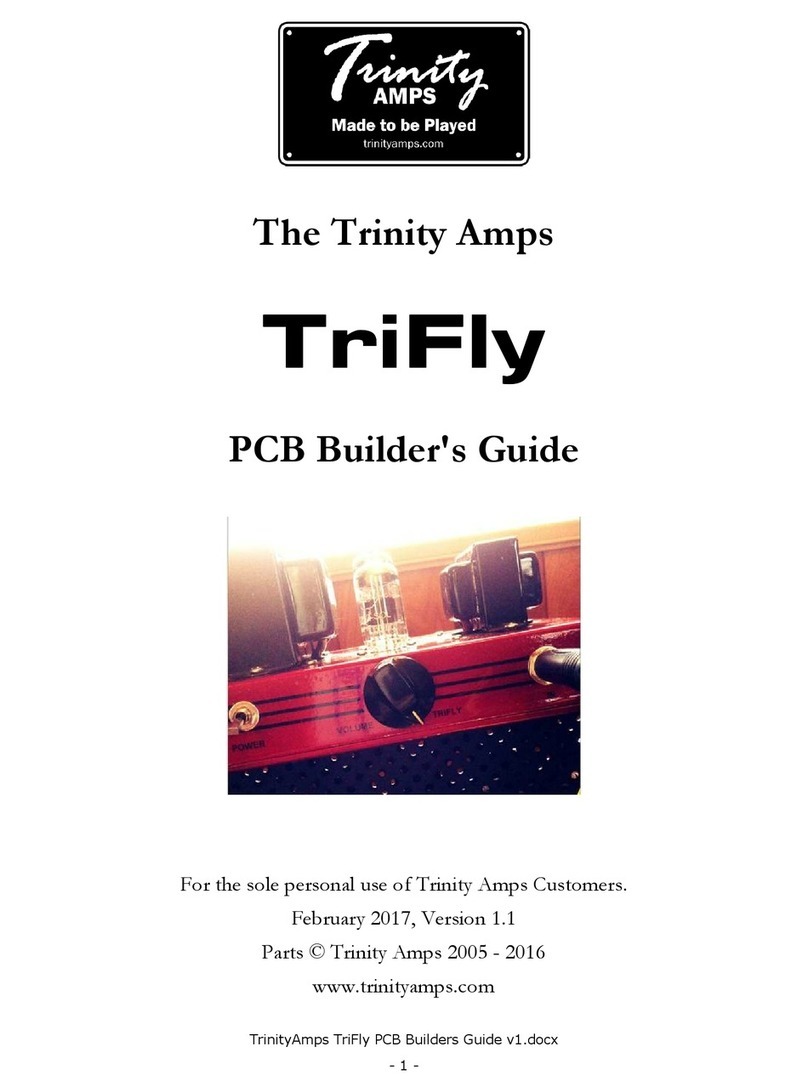
Trinity Amps
Trinity Amps TriFly User manual
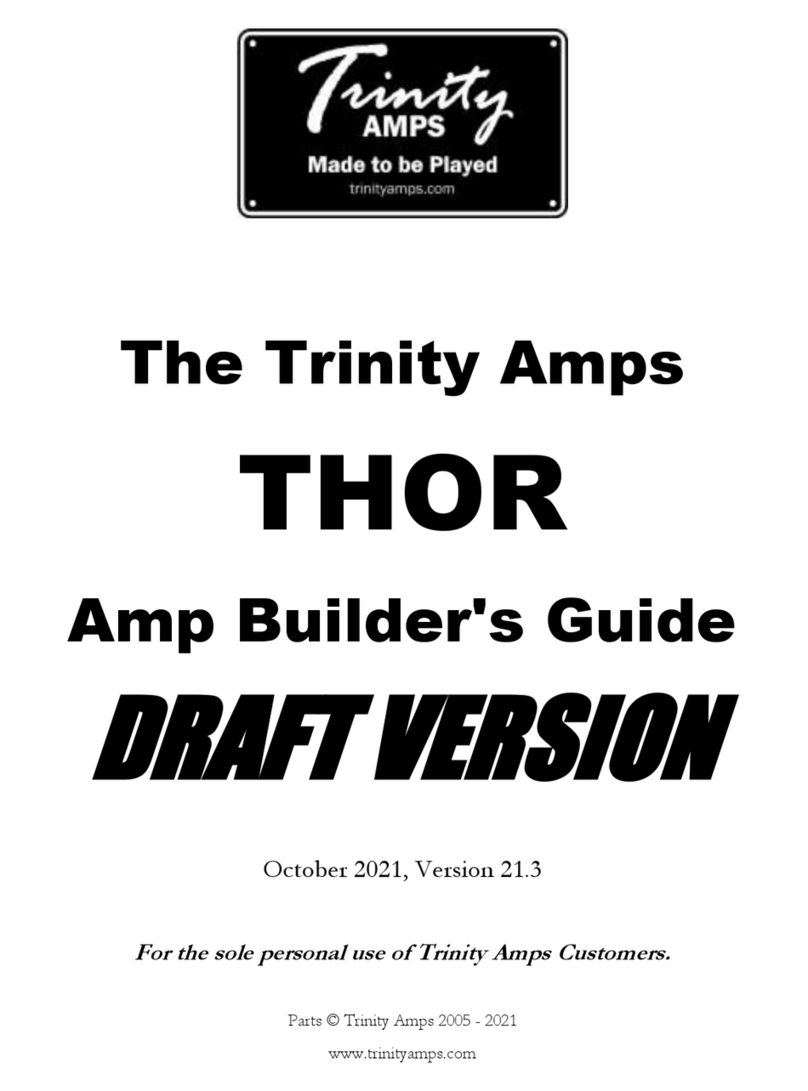
Trinity Amps
Trinity Amps THOR User manual
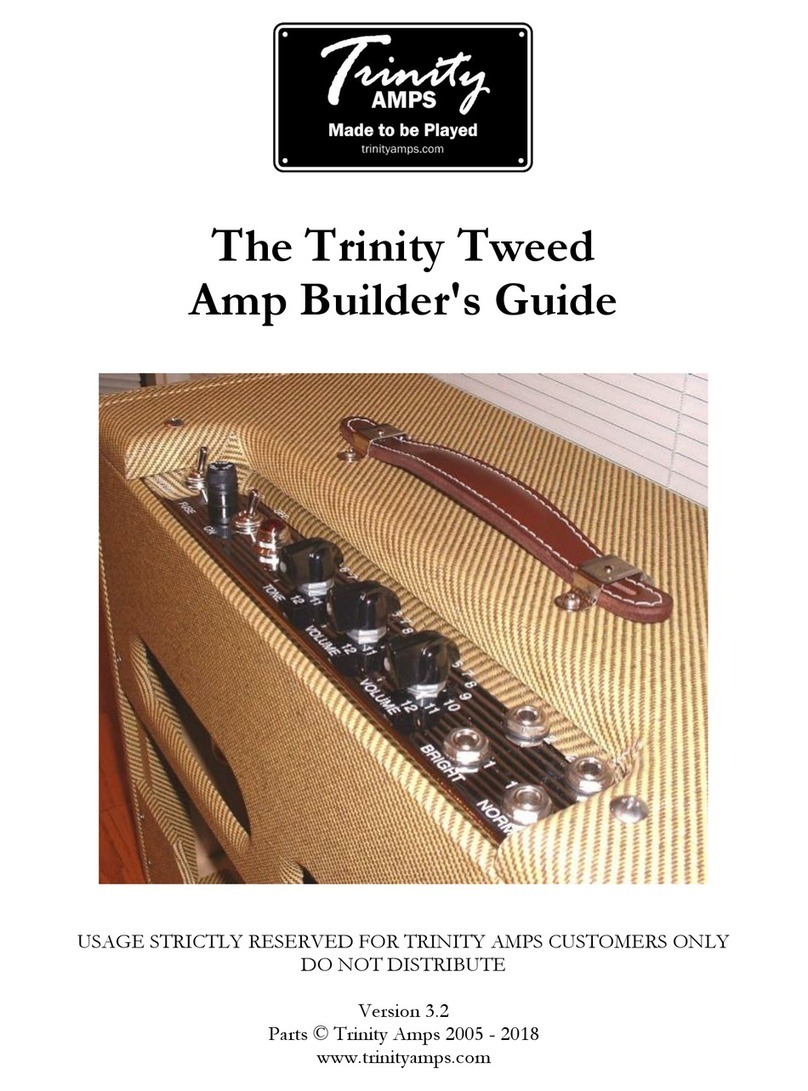
Trinity Amps
Trinity Amps Trinity Tweed Amp User manual
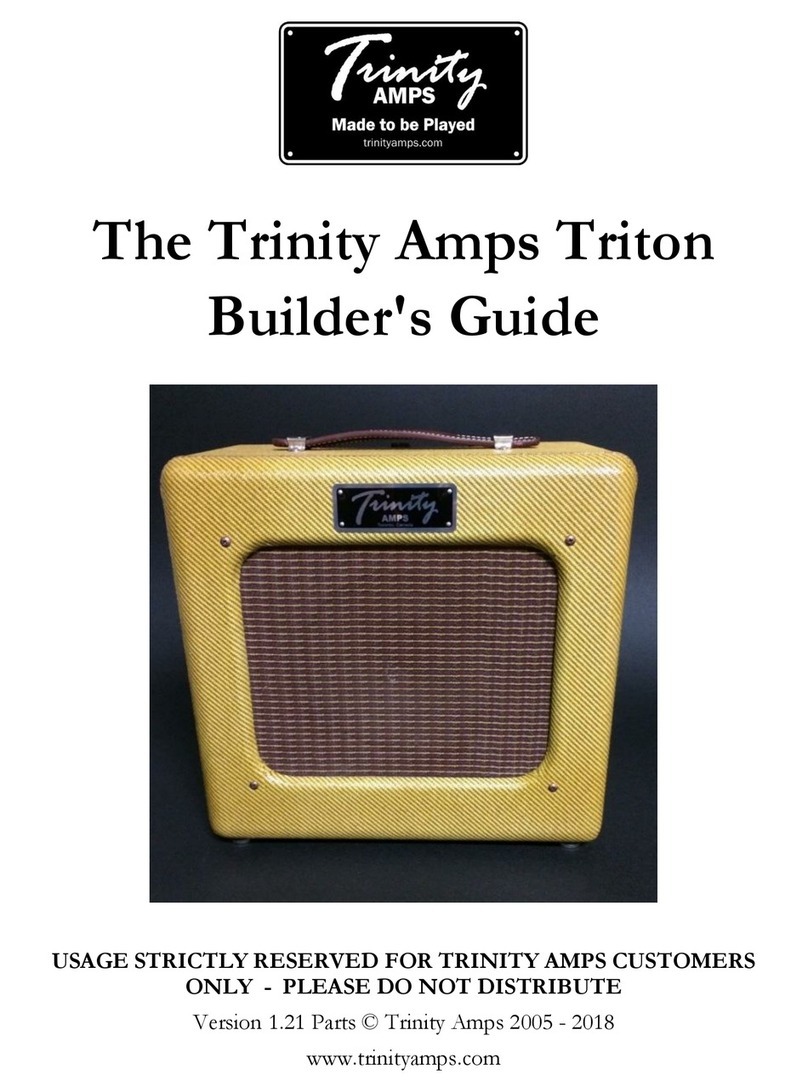
Trinity Amps
Trinity Amps Triton User manual
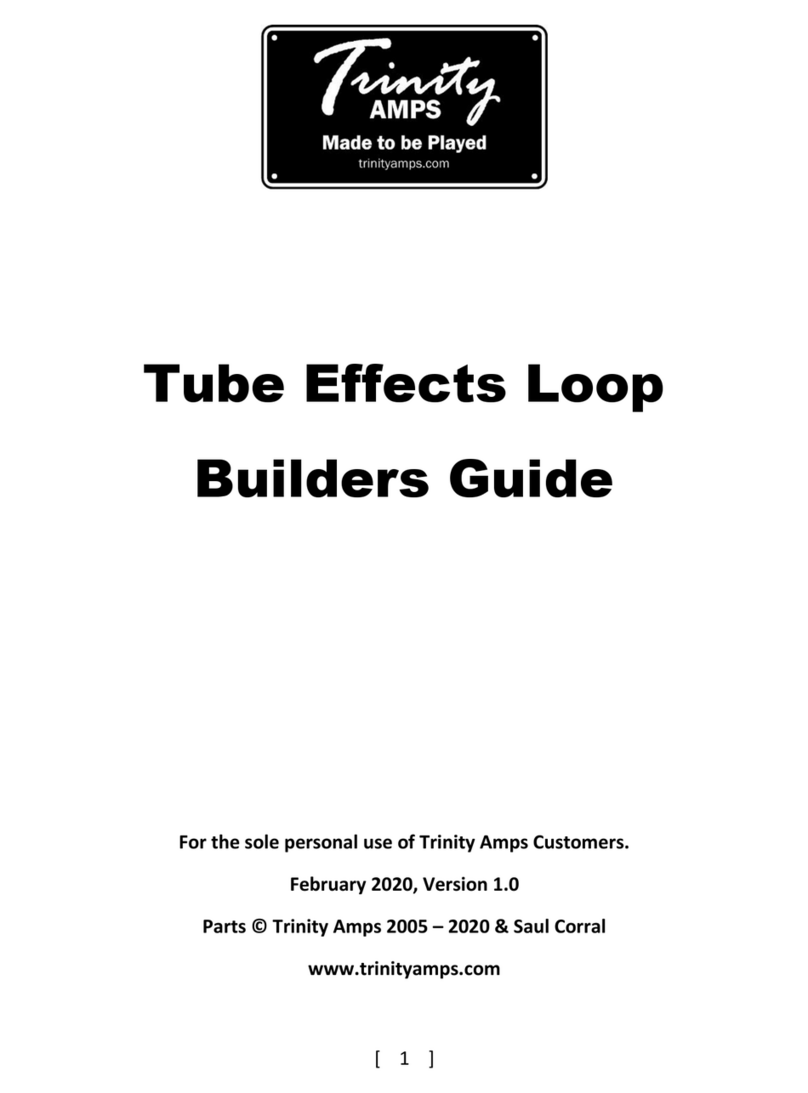
Trinity Amps
Trinity Amps Tube Effects Loop User manual
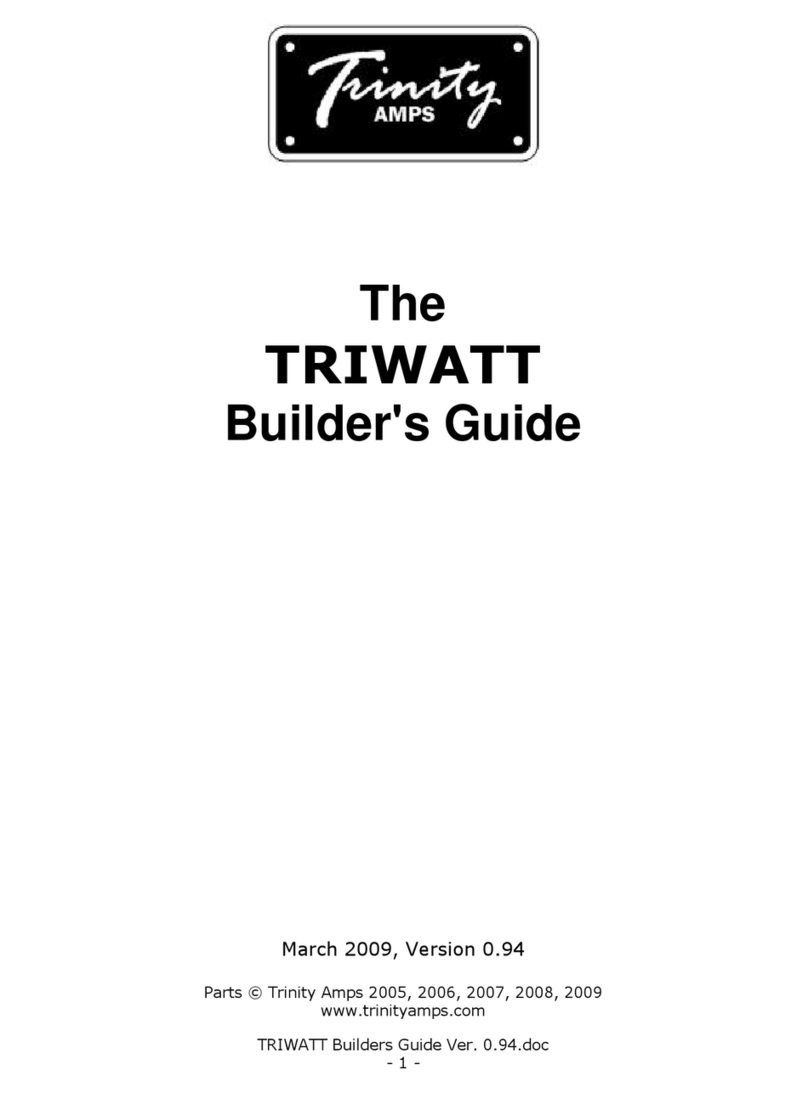
Trinity Amps
Trinity Amps TRIWATT User manual

Trinity Amps
Trinity Amps TRIP TOP User manual
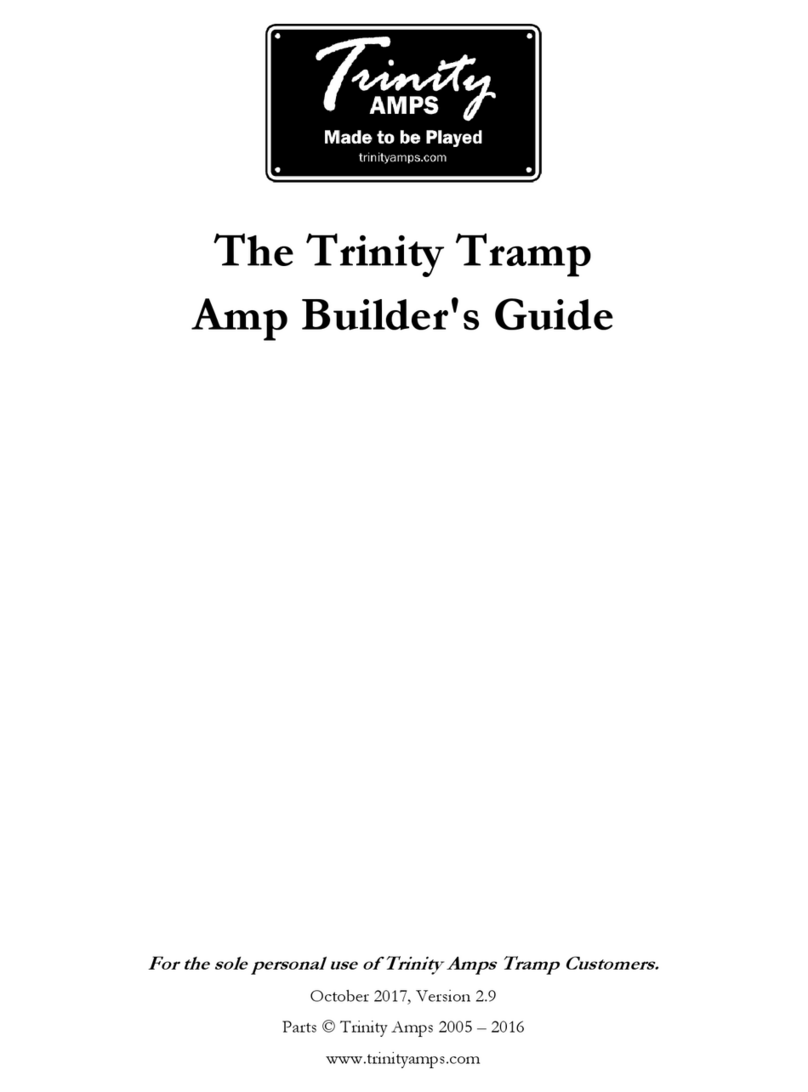
Trinity Amps
Trinity Amps Tramp User manual
